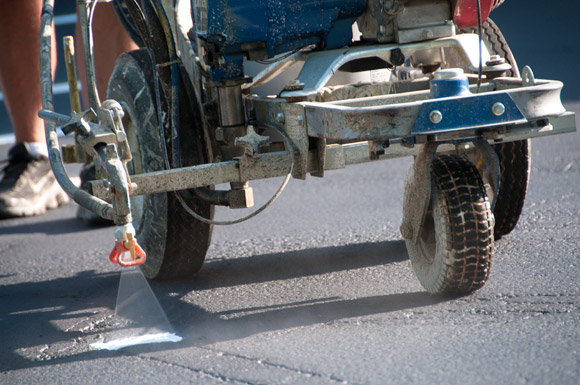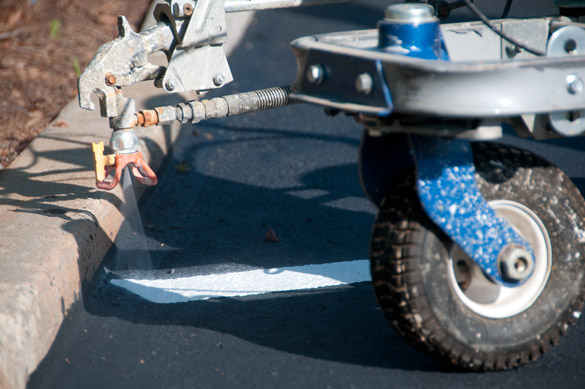I get asked 2 questions often, “How do you stripe straight?” and “How do you stop and start exactly where you want?”
Here’s what I’d like to do. I’d like to answer both questions simultaneously, because the answers are connected. I can’t separate the two. I’ll be detailed, give illustrations and then give a final recap. I hope it all helps.
Here we go. First, while striping keep your head still. I’ll give an illustration.
I coach baseball. When we coach pitchers we tell them, “don’t move your head”. Here’s the drill. When a right handed pitcher steps back with his left foot, his head remains motionless, directly above his right foot. The same goes for batting. When the pitcher steps back with his left foot, the batter also coils back, BUT, his head never moves either. It is the same with striping, so keep your head still.
Next then, when the pitcher strides forward, so does the batter BUT, only about 6”. Why? Because if he would stride forward 18” his head would drop to a different level, and so would his eyes. You don’t want that. So, keep your head still and take normal strides.
Next, here’s another picture. Runners and Olympic walkers don’t move their heads either. They glide along the same “plane”. Everything from their neck down moves but not their head. There’s no bouncing around, no swaying, no up and down stuff, just glide.
Related: Free Line Striping Course
OK? So here’s a recap. “Keep your head still” and “take normal strides”. That way, your eyes can focus.
The next question is “Where do you focus your eyes?”. I have another story. I took a couple of speed reading courses at California State University, Northridge (CSUN). Reading fast doesn’t depend solely upon “peripheral vision”. It depends on the right balance of “hard focusing” and “soft focusing”. Think of it as, also focused on what you see out of the corner of your eye. Keep that in mind.

Part 1) Lining Up Your Machine
Getting your machine where you want it involves 2 things:
A) Getting the tip guard, which houses the tip, just to the side of your chalk line.
B) Getting the machine to travel straight.
Here’s what I do. I hard focus on the chalk line and at the same time I soft focus on the tip guard, or vice versa. You decide. Remember, there isn’t any paint flow yet. When it does flow, I want the side of my stripe to land exactly on that chalk line. (I snap chalk lines to the side of where the stripe actually belongs, not down the middle.) Again, when the paint starts flowing, I want the side of my stripe to land exactly on that chalk line, not over it, not 1/4” away from it either. (That said, if you miss, don’t correct. I’ll say why later.) To get lined up, you may have to perform a “test shot” on a piece of cardboard for practice. You’ll get the idea.
Next, push the machine forward. Make sure you’re traveling parallel to the chalk line by staying hard focused on that chalk line and soft focused on the tip guard. If you’re traveling parallel, you’re ready to go.
Here’s a recap. Line up to the side of the chalk line. Hard focus on the chalk line and soft focus on the tip guard. Get parallel.
Part 2) Starting Out
I want you to know 2 things:
1) You don’t need a running start. Don’t think that. If full speed for you is 3 MPH, fine. You could put the gun directly over the starting point and just start walking.
2) Don’t try to drag race up to speed. Just start walking. Think of it as a grocery cart. So what if the customer gets 24 mils of paint during the first 12”? You won’t go broke. You don’t even have to add this into your paint costs! And it looks great and it’ll last. Relax and just start walking. You’ll get up to your speed in probably one stride. All that said, let’s get back on track.
Starting out here’s what I want you to do:
1) Remember that the line striping machine is already lined up.
2) Roll the machine back, to about 6” before your starting point. That’s all you need.
3) Hard focus on the starting point.
4) At the same time, get soft focused on the tip guard.
5) Again, stay hard focused on the starting point and soft focused on the tip guard, simultaneously.
6) Start walking. When you see from the corner of your eye that you’re directly over the starting point, pull the trigger. You’re hand will know when. Just stay relaxed and focused.
7) Get up to speed. This should take 1-2 or 3 normal strides. That’s it. Now you’re movin’.
Recap. You don’t have to start the line at full speed. And, it’s not a drag race. Hard focus on the starting point while soft focusing on the tip guard. Your hand will know when to pull the trigger. Hopefully, it’s right above your starting point.
 Part 3) Now that the paint is flowing,
Part 3) Now that the paint is flowing,
I only focus right where the paint hits the pavement. (I like that, “where the paint hits the pavement”.) And, that’s where you’ll remain hard focused for the remaining length of the line. (And, if you missed the chalk line by a quarter inch, don’t correct. Keep going straight. Just stay one quarter inch off the chalk line or over the chalk line, whichever the case may be! The chalk line is a guide. Just go straight.
Next, stopping right where you want. Let’s say you’re coming to the end of a 36’ line. Do this; keep a hard focus on the paint hitting the chalk line, then, when the stopping point comes into your peripheral vision, slow down, at least a little, and soft focus on it simultaneously. Now, read that again and picture it.
1) Don’t only hard focus on the paint hitting the chalk line. You’ll miss the stopping point.
2) Don’t only hard focus on the stopping point either. You’ll sway off the chalk line.
DON”T hard focus back and forth between the two! That’ll drive you nuts.
Let’s get back on track. When you see the stopping point coming into your peripheral vision, just think “there you are, I see you”. But, stay hard focused on the paint hitting the chalk line and stay soft focused on the stopping point. Your hand will know when to let go of the trigger. AND, this is important, you can slow down. You don’t have to stop the paint flow while traveling at full speed.
All that writing gets this last, little recap.
• Keep your head still. Take normal strides.
• Get your machine lined up by using the tip guard.
• Hard focus on the chalk line and soft focus on the tip guard.
• Roll your machine back, 6” before the starting point.
• Hard focus on the starting point while also soft focusing on the tip guard.
• Start walking. Keep your head still.
• Squeeze the trigger when you’re directly over the starting point.
• Hard focus where the paint hits the pavement. Keep your head still.
• When the stopping point comes into your peripheral vision, soft focus on it and slow down.
• Let go of the trigger when you’re directly over the stopping point.
• That’s it.
Again, all that writing gets this tiny little recap. Here’s why. It’s in the details.
Last, there are times, even now after thousands of jobs that I miss. But, it’s always because I’m either hurrying or I glance away at the wrong time, just human error. You’ll have that. But, you’ll also get better. Keep going. Keep in touch.
Dan Zurcher
American Striping
http://www.AmericanStriping.com




Dan, very useful information. I can’t wait until spring. Yes, I’m thinking spring already!